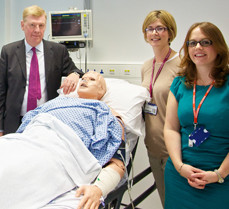Patient safety
Tweets from the top
Maintaining the safety of our patients will always be an absolute priority for the trust and, with nearly 8,000 staff treating over one million patients each year across 17 sites, one of our biggest challenges.
However, things don’t always go well and the consequences can be devastating. Many of you will have read the media coverage of the inquest into the death of Kane Gorny. Kane was admitted for an operation in 2009 with complex medical needs and we failed to care for him as we should have. Sadly he died as a result. I would like to apologise again on behalf of the trust for this failure in our duty of care and to say that we have taken action to protect other patients.
When things do go wrong, it is vital that we learn from them and adapt our approach to make sure we do not repeat our mistakes. At our last Board meeting we watched a patient story video in which the family of one of our recent patients discussed how we could have improved their care.
The video was the first in a series made by our patient safety team with patients who have recently been treated by the trust and their families. Each video focuses on a different aspect of patient safety and make up a training tool that is being rolled out across all areas of the trust.
The video the Board watched was a further powerful reminder of our responsibility to ensure the highest standards of care.
I have been at St George’s University Hospitals NHS Foundation Trust for nine months now and having spent a lot of time with our staff I am certain that the safety of our patients is the number one priority for everybody here. These patient story videos are one of the initiatives that will help to ensure that that remains the case.
Patient Safety Week last month gave us the perfect opportunity to reflect on the steps we take to keep our patients safe and where we can make further improvements.
Our patient safety conference included a keynote presentation from Sir Liam Donaldson, chair of the world alliance for patient safety and former chief medical officer for England.
We also had an exhibition showcasing over 35 patient safety projects developed across the trust, including 17 that focussed on medication safety, such as reducing venous thrombo-embolism (blood clots), and eight that focussed on improved communication and documentation.
We have also introduced some important changes including making improvements to patient information and encouraging patients to share their worries and concerns with a senior sister or matron on the ward so that they can be resolved quickly. We have also introduced a SBAR (situation, background, assessment and recommendation) tool across the trust to help staff fully evaluate each patient and to gather all the necessary information to ensure accurate and timely communication between clinical teams.
I am determined that we develop an open reporting and learning culture as a trust. Last year saw a 41% increase in reported patient safety incidents from 2010/11. This is something I am proud of as the National Patient Safety Agency states that “organisations that report more incidents usually have a better and more effective safety culture. You can’t learn and improve if you don’t know what the problems are.”
Feedback
If you would like to comment on the topic you can email me at communications@stgeorges.nhs.uk.


